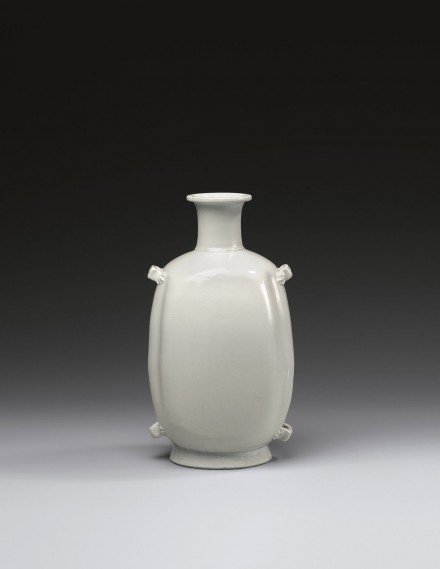J.J. Lally & Co., Oriental Art / New York City, New York
MenuPast Exhibition
Chinese Ceramics in Black and White
March 20–April 10, 2010

14.
A XINGYAO WHITE PORCELAIN BOTTLE-VASE
Late Tang–Five Dynasties, A.D. 9th–10th Century
following a leather canteen shape, the tall gently rounded sides gathered into pairs of shallow rounded lobes and applied with twin squared lug handles with ‘riveted’ ends at the shoulder and base, straddling the lobes, lightly engraved with a double-line border around the outer edge of the broad rounded shoulders surmounted by a waisted cylindrical neck rising from a raised line band to a wide flat everted rim with squared lip, covered with a glossy transparent glaze of pale bluish tone ending unevenly around the exterior of the splayed sides of the high ring foot revealing the fine white porcelain body, the recessed base also glazed.
Height 91⁄2 inches (24.2 cm)
From the Collection of Carl Kempe (1884–1967), Ekolsund, Sweden, no. 388
Exhibited
Kunst Industri Museet, Copenhagen, 1950
Mostra d’Arte Cinese (Exhibition of Chinese Art), Palazzo Ducale, Venice, 1954
The Ceramic Art of China, The Oriental Ceramic Society, London, 1971
Published
Mostra d’Arte Cinese (Exhibition of Chinese Art), Palazzo Ducale, Venice, 1954, p. 111, no. 366
Gyllensvärd, Chinese Ceramics in the Carl Kempe Collection, Stockholm, 1964, p. 125, pl. 388
The Ceramic Art of China, The Oriental Ceramic Society, London, 1971, no. 60
Gyllensvärd, The World’s Great Collections: Oriental Ceramics, Vol. 8, Museum of Far Eastern Antiquities, Stockholm, Tokyo, 1982, pl. 98
Chinese Ceramic Treasures: A Selection from Ulricehamn East Asian Museum, Including The Carl Kempe Collection, Ulricehamn, 2002, pl. 590
A Xingyao white porcelain vase of this same form in the collection of the Shanghai Museum is illustrated in Qiannian Xingyao (Xing Kiln in its Millennium), Beijing, 2007, p. 168, together with another example, ibid, on p. 169; and the same vase from the Shanghai Museum is also illustrated in Zhongguo taoci quanji (6) Tang-Wudai (The Complete Works of Chinese Ceramics, Vol. 6, Tang–Five Dynasties), Shanghai, 2000, p. 200, no. 225 and several other publications, including A Dictionary of Chinese Ceramics, Singapore, 2002, p. 171, where the scholar Wang Qingzhen points out that this type of white porcelain bottle in the Tang dynasty was famously called ‘the Neiqiu bottle,’ referring to the place where it was made, at the Xing kilns located in Neiqiu, Hebei province, which was under the administration of Xingzhou prefecture.
Another white porcelain vase of this distinctive form from the Avery Brundage Collection, in the Asian Art Museum of San Francisco, is illustrated by He Li in Chinese Ceramics: The New Standard Guide, London, 1996, p. 90, no. 136, with description on p. 120; and the same vase was previously published by Watson in Tang and Liao Ceramics, London, 1984, p. 145, no. 124.
Compare also the white porcelain vase of this form in the collection of the National Palace Museum, Taipei, published in Illustrated Catalogue of Sung Dynasty Porcelain in the National Palace Museum: Ting Ware and Ting-Type ware, Taipei, 1973, no. 1.
晚唐/五代 邢窰白瓷穿帶壺 高 24.2 厘米
14.
A XINGYAO WHITE PORCELAIN BOTTLE-VASE
Late Tang–Five Dynasties, A.D. 9th–10th Century
Height 91⁄2 inches (24.2 cm)